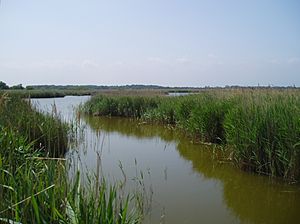Hickling Broad facts for kids
Quick facts for kids Hickling Broad |
|
|---|---|
 |
|
| Type | Nature reserve |
| Location | Stalham, Norfolk |
| OS grid | TG 428 222 |
| Area | 600 hectares (1,500 acres) |
| Managed by | Norfolk Wildlife Trust |
Hickling Broad is a huge nature reserve in Norfolk, England. It covers about 600 hectares (that's like 1,500 football fields!). It's located near Stalham, north-east of Norwich. The Norfolk Wildlife Trust looks after this special place.
Hickling Broad is so important that it's been named a National Nature Reserve. It's also part of the beautiful Norfolk Coast Area of Outstanding Natural Beauty. This means the area is protected because of its amazing scenery and wildlife.
It's the biggest "broad" (which is a type of lake) in the area. The water here is a little bit salty, or brackish, because it's quite close to the sea. Even though it's large, much of the broad is quite shallow, with the main boat channel only about 1.5 meters deep. It's one of the largest open water areas in East Anglia.
Contents
Amazing Wildlife at Hickling Broad
Hickling Broad is home to an incredible variety of plants and animals, especially many rare ones. It has the biggest area of reeds in all of England! These reeds are like tall grasses that grow in the water and provide a perfect home for many creatures.
Rare Plants and Insects
You can find some very special water plants here, like the holly-leaved naiad and three types of rare stonewort. These plants are important for the ecosystem.
The reserve is also a haven for rare insects. Keep an eye out for the beautiful Swallowtail butterfly, which is a unique type found only in Britain. Its caterpillars love to munch on a plant called milk-parsley. You might also spot the Norfolk hawker dragonfly and the large Emperor dragonfly zipping around.
Birds of Hickling Broad
Hickling Broad is a fantastic spot for birdwatching. Many different birds visit or live here all year round.
In the colder winter months, you might see elegant cranes, goldeneyes, shovelers, and teals. These birds come to the broad to find food and shelter.
Other birds stay at Hickling Broad for most of the year. These include the secretive bitterns, majestic marsh harriers, diving pochards, shy water rails, and the tiny, loud Cetti's warblers. There's a special walking path around the broad that lets you explore and try to spot these amazing birds.
Hickling Broad and Seaplanes
Did you know that Hickling Broad has a surprising history with planes? During World War I, from 1916 to 1918, the Royal Naval Air Service (RNAS) used Hickling Broad as a backup base for their seaplanes. Seaplanes are aircraft that can land and take off from water.
The main RNAS base was at South Denes near Great Yarmouth. However, if the sea was too rough for seaplanes to land there, they could come to the calmer waters of Hickling Broad instead. This arrangement is still in place today!
Contractors even started building a concrete ramp for the seaplanes at Hickling, but it was never finished. In the end, Hickling Broad was only used for two emergency landings during the war.
There's a special Blue Plaque in Regent Street in Great Yarmouth that tells more about the RNAS headquarters there. It mentions how they flew both land and seaplanes and were very involved in fighting against German airships called Zeppelins during World War I.
Images for kids


